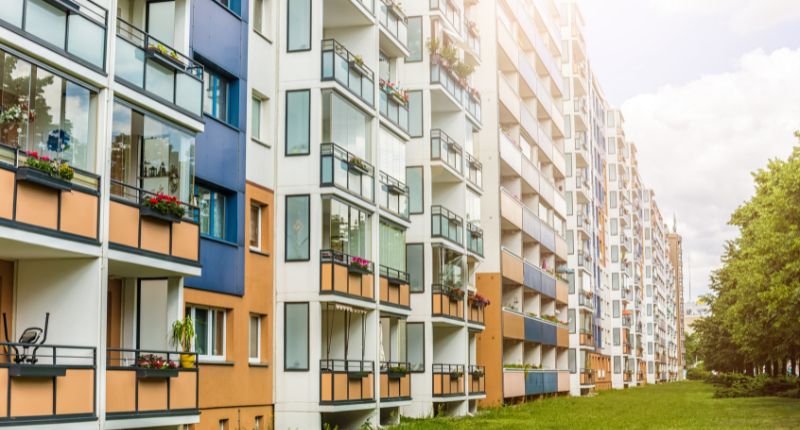
- Australia's vacancy rate remains well below a balanced market.
- Rental gains have slowed this quarter compared to previous quarter.
- 40,000 to 70,000 additional rentals needed to get back to a balanced market.
Australian vacancy rates have plummeted back to a record low of 0.8%, according to Domain‘s rent report for the September quarter of 2023.
The nation’s rental market, combined with continual rent increases, remains a landlords’ market.
Earlier this year, PropTrack economist, Anne Flaherty, noted that the combined pressures of a lack of supply and a surge of immigration is contributing to the nationwide rental crisis.
Additionally, increased construction costs and delays have only further aggravated the supply shortage.
“Ultimately, the solution to alleviating the current rental crisis is for governments to prioritise policies that expedite and promote the development of new homes,” she said.
The latest SQM weekly rent listings show that units and houses are at incredibly low levels.
Unsurprisingly, according to Domain’s latest data, the situation for tenants remains dire. Most capital cities have seen vacancy rates slide even further, with Sydney and Perth recording record lows of 0.9% and 0.3%, respectively. Melbourne, Brisbane, Adelaide and Darwin are close to record lows at 0.9%, 0.7%, 0.3%, and 0.7%, respectively.
These figures are far below the 2.5% to 3.5% that the Real Estate Institute of Western Australia (REIWA) considers to be a balanced market.
Rental gains begin to slow despite a falling vacancy rate
Domain chief of research and economics, Nicola Powell, noted that rental gains have eased over the September quarter compared to the previous quarter.
Weekly asking rent for houses
| Capital city | Sep-23 | Jun-23 | Sep-22 | QoQ | YoY |
|---|---|---|---|---|---|
| Sydney | $720 | $700 | $650 | 2.9% | 10.8% |
| Melbourne | $550 | $520 | $470 | 5.8% | 17.0% |
| Brisbane | $590 | $580 | $550 | 1.7% | 7.3% |
| Adelaide | $550 | $540 | $490 | 1.9% | 12.2% |
| Perth | $600 | $580 | $500 | 3.4% | 20.0% |
| Canberra | $655 | $675 | $680 | -3.0% | -3.7% |
| Darwin | $650 | $650 | $610 | 0.0% | 6.6% |
| Hobart | $530 | $530 | $540 | 0.0% | -1.9% |
| Combined Capitals | $600 | $580 | $530 | 3.4% | 13.2% |
| Combined Regionals | $520 | $510 | $490 | 2.0% | 6.1% |
Source: Domain.
“It is important to recognise that it is unusual for rent gains to decelerate when Australia’s vacancy rate is at a record low,” said Powell.
“This suggests an affordability ceiling is being reached as strained tenant budgets cannot keep pace with escalating rents and living costs.
“These dynamics are likely to have led to a reconsideration of house shares or opting for a more affordable location, property type or size with recent RBA research suggesting that the average number of people per dwelling is rising.”
Similar observations were made by CoreLogic’s Tim Lawless.
| Capital city | Sep-23 | Jun-23 | Sep-22 | QoQ | YoY |
|---|---|---|---|---|---|
| Sydney | $680 | $670 | $550 | 1.5% | 23.6% |
| Melbourne | $520 | $500 | $425 | 4.0% | 22.4% |
| Brisbane | $550 | $530 | $460 | 3.8% | 19.6% |
| Adelaide | $450 | $430 | $400 | 4.7% | 12.5% |
| Perth | $500 | $480 | $420 | 4.2% | 19.0% |
| Canberra | $550 | $550 | $550 | 0.0% | 0.0% |
| Darwin | $520 | $515 | $500 | 1.0% | 4.0% |
| Hobart | $450 | $450 | $450 | 0.0% | 0.0% |
| Combined Capitals | $600 | $580 | $485 | 3.4% | 23.7% |
| Combined Regionals | $450 | $450 | $400 | 0.0% | 12.5% |
Source: Domain.
Achieving a balanced market
In order for Australia to achieve a balanced rental market (between 2% and 3%, according to Domain), Powell suggests an additional 40,000 to 70,000 rentals are needed.
However, she added, “There is no quick fix to ease the competitive rental market, as many factors are at play.”
Powell said one of the key factors is investors, who are currently reluctant to hold debt with rising costs, as evidenced by the falling annual investor share of new lending.
“Discussions of higher taxes in Queensland and Victoria will only act as a deterrent for future investors who seek certainty,” she said.
“For example, the Victorian government is looking to introduce a levy on short-stay accommodation providers from 2025 onward.
“While it might help boost overall supply and raise revenue for social and affordable housing, this could create negative sentiment among investors, discouraging them from entering the renal market even further.
“In a time of increasing demand, policies should aim to encourage investors and not disincentive them.”







